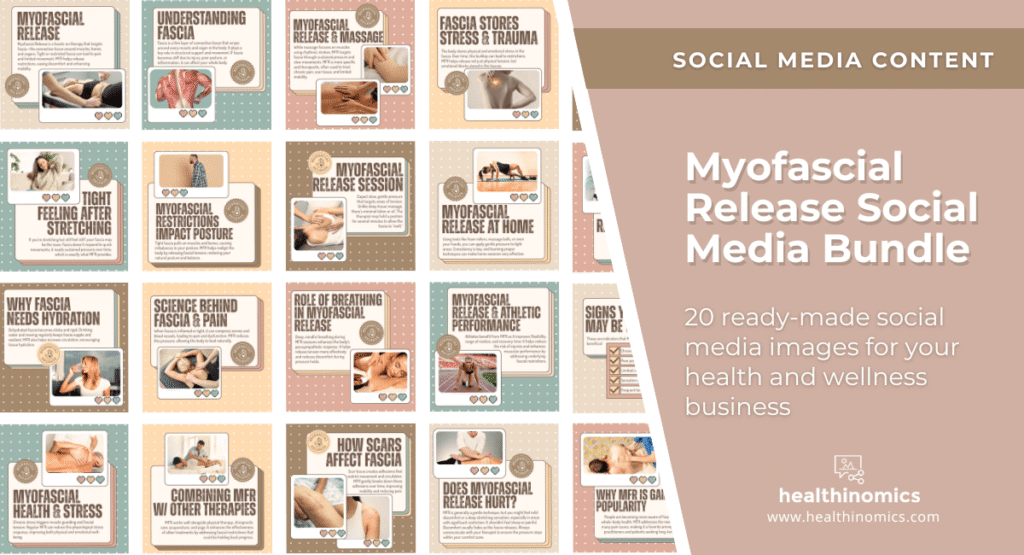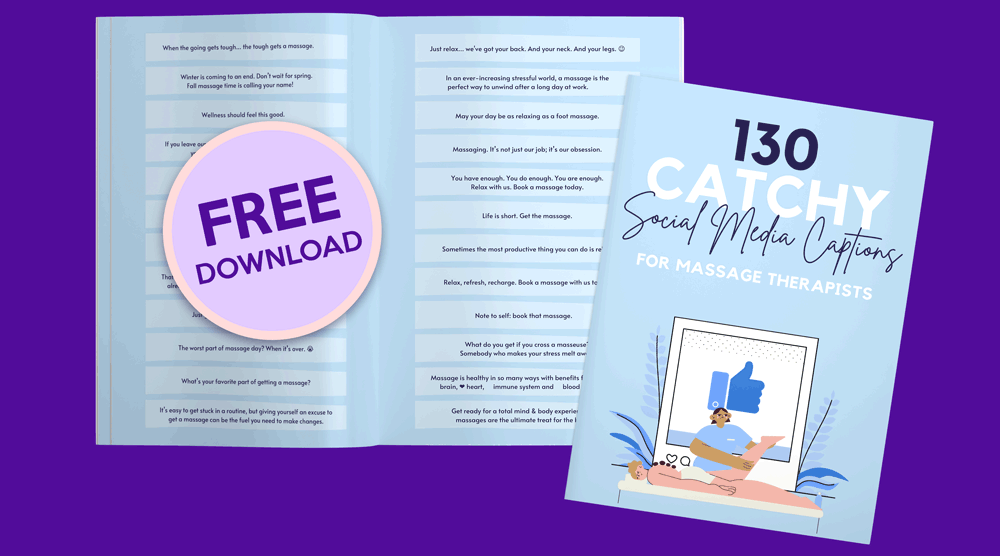Inside the Social Media Bundle
BONUS 20 sample captions for you to share with your bundle!
BONUS Editable Canva Template!
The Myofascial Release Social Media bundle includes 20 beautiful pieces of visual content ready to share.
Social Media Image Content Ready To Share
1. What is Myofascial Release and Why It Matters
Myofascial Release is a hands-on therapy that targets fascia—the connective tissue around muscles, bones, and organs. Tight or restricted fascia can lead to pain and limited movement. MFR helps release restrictions, easing discomfort and enhancing mobility.
2. Understanding Fascia
Fascia is a thin layer of connective tissue that wraps around every muscle and organ in the body. It plays a key role in structural support and movement. If fascia becomes stiff due to injury, poor posture, or inflammation, it can affect your whole body.
3. Myofascial Release and Massage
While massage focuses on muscles using rhythmic strokes, MFR targets fascia through sustained pressure and slow movements. MFR is more specific and therapeutic, often used to treat chronic pain, scar tissue, and limited mobility.
4. Fascia Stores Stress and Trauma
The body stores physical and emotional stress in the fascia. Over time, this buildup can lead to restrictions. MFR helps release not just physical tension, but also emotional blocks stored in the tissues.
5. Common Conditions MFR Can Help With
MFR is beneficial for conditions like:
– Chronic neck and back pain
– TMJ dysfunction
– Fibromyalgia
– Sciatica
– Carpal tunnel syndrome
– Plantar fasciitis
– Post-surgical pain and scar tissue
6. Tight Feeling After Stretching
If you’re stretching but still feel stiff, your fascia may be the issue. Fascia doesn’t respond to quick movements; it needs sustained pressure over time, which is exactly what MFR provides.
7. Myofascial Restrictions Impact Posture
Tight fascia pulls on muscles and bones, causing imbalances in your posture. MFR helps realign the body by releasing fascial tension, restoring your natural posture and balance.
8. Myofascial Release Session
Expect slow, gentle pressure that targets areas of tension. Unlike deep tissue massage, there’s minimal lotion or oil. The therapist may hold a position for several minutes to allow the fascia to “melt.”
9. Myofascial Release at Home
Using tools like foam rollers, massage balls, or even your hands, you can apply gentle pressure to tight areas. Consistency is key, and learning proper techniques can make home sessions very effective.
10. How Long Does It Take to See Results?
Some people feel relief immediately, while others may need several sessions. It depends on the severity of restrictions, your health history, and how your body responds to treatment.
11. Why Fascia Needs Hydration
Dehydrated fascia becomes sticky and rigid. Drinking water and moving regularly keep fascia supple and resilient. MFR also helps increase circulation, encouraging tissue hydration.
12. Science Behind Fascia and Pain
When fascia is inflamed or tight, it can compress nerves and blood vessels, leading to pain and dysfunction. MFR reduces this pressure, allowing the body to heal naturally.
13. Role of Breathing in Myofascial Release
Deep, mindful breathing during MFR sessions enhances the body’s parasympathetic response. It helps release tension more effectively and reduces discomfort during pressure holds.
14. Myofascial Release and Athletic Performance
Athletes benefit from MFR as it improves flexibility, range of motion, and recovery time. It helps reduce the risk of injuries and enhances muscular performance by addressing underlying fascial restrictions.
15. Signs Your Fascia Might Be Tight
These are indicators that MFR could be beneficial.
– Chronic pain without a clear cause
– Poor posture
– Limited range of motion
– Sensation of tightness or pulling
– Frequent tension headaches
16. Myofascial Health and Stress
Chronic stress triggers muscle guarding and fascial tension. Regular MFR can reduce this physiological stress response, improving both physical and emotional well-being.
17. Combining MFR with Other Therapies
MFR works well alongside physical therapy, chiropractic care, acupuncture, and yoga. It enhances the effectiveness of other treatments by addressing fascial restrictions that could be holding back progress.
18. How Scars Affect Fascia
Scar tissue creates adhesions that restrict movement and circulation. MFR gently breaks down these adhesions over time, improving mobility and reducing pain.
19. Is Myofascial Release Supposed to Hurt?
MFR is generally a gentle technique, but you might feel mild discomfort or a deep stretching sensation, especially in areas with significant restriction. It shouldn’t feel sharp or painful. Discomfort usually fades as the fascia releases. Always communicate with your therapist to ensure the pressure stays within your comfort zone.
20. Why Myofascial Release is Gaining Popularity
People are becoming more aware of fascia’s role in whole-body health. MFR addresses the root cause of many pain issues, making it a favorite among holistic practitioners and patients seeking long-term relief.
Already purchased a subscription? Log In
- Includes 20 ready-made Images
- All images are high resolution PNG
- Includes fully editable Canva template
- Includes 20 social media post captions
- Add your own branding!
Share this:
Already purchased a subscription? Log In
- Includes 20 ready-made Images
- All images are high resolution PNG
- Includes fully editable Canva template
- Includes 20 social media post captions
- Add your own branding!



